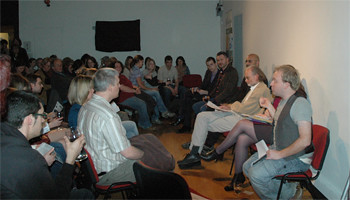By Keir Waddington, Cardiff School of History, Archeaology and Religion
In using the intellectual and emotional ménage à trois between Jung, Freud and Spielrein to explore Edwardian debates about psychoanalysis, Cronenberg uses history in particular ways. While Freud himself was never interested in film, Cronenberg’s cinematic history repackages popular ideas about psychoanalysis, presenting a narrative bristling with lengthy expositions, father figures, word association, and the interpretation of dreams to feature what many believe are psychoanalysts’ core preoccupations – sexual transgression, Oedipal complexes, neurosis and suppression all wrapped in Edwardian manners. If A Dangerous Method departs from usual cinematic representations of psychoanalysts in its efforts to uncover the historical and philosophical backbone of modernity, Cronenberg’s history needs, much like the dreams recounted in the film, to be interpreted.
Leaving aside that it was Anna O, Freud’s first patient, who coined the term “the talking cure”, that Freud first used the term psychoanalysis in 1896, and that others were experimenting with his methods before Jung, including British psychiatrists who adopted aspects of “the talking cure”, Cronenberg’s beautifully composed film gets some of the story right. Certainly, Jung admired Freud’s work, notably his Interpretation of Dreams (1900), and a paternalistic and troubled relationship did develop between them. As A Dangerous Method shows, Freud considered Jung his natural successor until they fell out in 1912 for a variety of personal and professional reasons, including theoretical differences about the libido and the unconscious. Jung was interested in the occult – he wrote his doctorate on the psychopathology of the occult – and as the film shows he researched word association, though Cronenberg neglects to tell us that the relationship between Jung and Freud started after Jung sent Freud his work on word association, which he believed supported Freud’s theories. Equally, Spielrein was a patient of Jung’s at Burghölzii asylum and they did have an affair. While medical ethics at the time were more about conduct between doctors rather than between doctors and patients, and popular imagery of medical practitioners often associated them with a rapacious sexuality, Jung was dismissed when the affair with Spielrein became known. Spielrein did go on to be a colleague of Jung’s and worked with Freud before returning to Russia, while Otto Gross did have an influence on Jung, who later claimed that his entire worldview changed when he treated Gross. So far so good.
At one level, Cronenberg might be forgiven for not giving the viewer much of the context of Freud and Jung’s ideas. While this is hard to do in a film, it does mean that Cronenberg’s history is a selective one, particularly with regard to how many continental psychiatrists at the time were becoming concerned with new theories of the mind – both organic interpretations associated with neuropathology and more psychotherapeutic models. As the film suggests, work therapy and hydrotherapy were employed in asylums; restraint was used for violent patients, but psychiatrists other than Freud and Jung, particularly those in France and Germany, were also turning to new approaches with a new group of neurotic and hysterical patients who it was felt were amenable to psychodynamic treatments. Equally, the period saw new theories about sexuality and an interest in ‘sexual inversions’ or perversions.
Freud and Jung were influenced by these ideas, but we do not see this in A Dangerous Method. Although Phillip French in the Guardian argues that the film is an ‘objective, historical look at the early days of psychoanalysis’, Cronenberg offers up another version of the ‘founding’ myth of psychoanalysis. While he adds in Jung and Spielrein, A Dangerous Method downplays how psychoanalysis was part of a larger psychotherapeutic movement; overlooks how Freud’s ideas were shaped by work on neuropathology, hysteria and hypnosis; and misses out some great stories, such as how Freud advocated the use of cocaine as a mental stimulant and aphrodisiac or how his claims about incest in Viennese society nearly got him into trouble. Cronenberg equally overlooks that Bleuler, the director of Burghölzii who appears fleetingly in A Dangerous Method, was a key earlier promoter Freud’s ideas, influencing Jung to use word association to test Freud’s theories. Cronenberg’s vision of the history of psychoanalysis equally overstates public opposition, telling us more about contemporary anxieties among psychoanalysts in North America than it does about the Edwardian dimension. True, the sexual dimension of Freud’s ideas was unpalatable but was more often downplayed as evidence suggests that the British public enthusiastically took to work on the interpretation of dreams. Cronenberg also gives his characters a degree of prescience – for example, in how Jung dream foretells the First World War or in Freud’s warning that psychoanalysis represents a ‘plague’ coming to America where psychoanalysis was to have a considerable influence after 1945 – which says more about his sense of inevitability than it does about the period.
And finally, there is the relationship between Jung and Spielrein and of course the spanking. True, Spielrein was beaten by her father. True, Jung lied to Freud about Spielrein, suggesting that she was a fantasist. It is true that women were institutionalised because they were viewed, as Spielrein describes herself, as ‘vile and filthy and corrupt’, but there is also evidence (such as from contemporary pornography) that Edwardians engaged in and enjoyed a broad spectrum of sexuality, which was not always seen as aberrant. More importantly, there is no evidence that Jung and Spielrein’s relationship was a sadomasochistic one. If the sadomasochistic dimension is untrue, Cronenberg further misrepresents the relationship between Spielrein and Jung: Jung was her dissertation supervisor, while he and Freud belittled Spielrein as a colleague while simultaneously using her ideas about the ‘death instinct’.
Cronenberg then prefers a racier history that continues to support the foundation myths about psychoanalysis. His A Dangerous Method helps obscure some of the richness out of which psychoanalysis developed, and downplays the other interesting histories that might be told.
In using the intellectual and emotional ménage à trois between Jung, Freud and Spielrein to explore Edwardian debates about psychoanalysis, Cronenberg uses history in particular ways. While Freud himself was never interested in film, Cronenberg’s cinematic history repackages popular ideas about psychoanalysis, presenting a narrative bristling with lengthy expositions, father figures, word association, and the interpretation of dreams to feature what many believe are psychoanalysts’ core preoccupations – sexual transgression, Oedipal complexes, neurosis and suppression all wrapped in Edwardian manners. If A Dangerous Method departs from usual cinematic representations of psychoanalysts in its efforts to uncover the historical and philosophical backbone of modernity, Cronenberg’s history needs, much like the dreams recounted in the film, to be interpreted.
Leaving aside that it was Anna O, Freud’s first patient, who coined the term “the talking cure”, that Freud first used the term psychoanalysis in 1896, and that others were experimenting with his methods before Jung, including British psychiatrists who adopted aspects of “the talking cure”, Cronenberg’s beautifully composed film gets some of the story right. Certainly, Jung admired Freud’s work, notably his Interpretation of Dreams (1900), and a paternalistic and troubled relationship did develop between them. As A Dangerous Method shows, Freud considered Jung his natural successor until they fell out in 1912 for a variety of personal and professional reasons, including theoretical differences about the libido and the unconscious. Jung was interested in the occult – he wrote his doctorate on the psychopathology of the occult – and as the film shows he researched word association, though Cronenberg neglects to tell us that the relationship between Jung and Freud started after Jung sent Freud his work on word association, which he believed supported Freud’s theories. Equally, Spielrein was a patient of Jung’s at Burghölzii asylum and they did have an affair. While medical ethics at the time were more about conduct between doctors rather than between doctors and patients, and popular imagery of medical practitioners often associated them with a rapacious sexuality, Jung was dismissed when the affair with Spielrein became known. Spielrein did go on to be a colleague of Jung’s and worked with Freud before returning to Russia, while Otto Gross did have an influence on Jung, who later claimed that his entire worldview changed when he treated Gross. So far so good.
At one level, Cronenberg might be forgiven for not giving the viewer much of the context of Freud and Jung’s ideas. While this is hard to do in a film, it does mean that Cronenberg’s history is a selective one, particularly with regard to how many continental psychiatrists at the time were becoming concerned with new theories of the mind – both organic interpretations associated with neuropathology and more psychotherapeutic models. As the film suggests, work therapy and hydrotherapy were employed in asylums; restraint was used for violent patients, but psychiatrists other than Freud and Jung, particularly those in France and Germany, were also turning to new approaches with a new group of neurotic and hysterical patients who it was felt were amenable to psychodynamic treatments. Equally, the period saw new theories about sexuality and an interest in ‘sexual inversions’ or perversions.
Freud and Jung were influenced by these ideas, but we do not see this in A Dangerous Method. Although Phillip French in the Guardian argues that the film is an ‘objective, historical look at the early days of psychoanalysis’, Cronenberg offers up another version of the ‘founding’ myth of psychoanalysis. While he adds in Jung and Spielrein, A Dangerous Method downplays how psychoanalysis was part of a larger psychotherapeutic movement; overlooks how Freud’s ideas were shaped by work on neuropathology, hysteria and hypnosis; and misses out some great stories, such as how Freud advocated the use of cocaine as a mental stimulant and aphrodisiac or how his claims about incest in Viennese society nearly got him into trouble. Cronenberg equally overlooks that Bleuler, the director of Burghölzii who appears fleetingly in A Dangerous Method, was a key earlier promoter Freud’s ideas, influencing Jung to use word association to test Freud’s theories. Cronenberg’s vision of the history of psychoanalysis equally overstates public opposition, telling us more about contemporary anxieties among psychoanalysts in North America than it does about the Edwardian dimension. True, the sexual dimension of Freud’s ideas was unpalatable but was more often downplayed as evidence suggests that the British public enthusiastically took to work on the interpretation of dreams. Cronenberg also gives his characters a degree of prescience – for example, in how Jung dream foretells the First World War or in Freud’s warning that psychoanalysis represents a ‘plague’ coming to America where psychoanalysis was to have a considerable influence after 1945 – which says more about his sense of inevitability than it does about the period.
And finally, there is the relationship between Jung and Spielrein and of course the spanking. True, Spielrein was beaten by her father. True, Jung lied to Freud about Spielrein, suggesting that she was a fantasist. It is true that women were institutionalised because they were viewed, as Spielrein describes herself, as ‘vile and filthy and corrupt’, but there is also evidence (such as from contemporary pornography) that Edwardians engaged in and enjoyed a broad spectrum of sexuality, which was not always seen as aberrant. More importantly, there is no evidence that Jung and Spielrein’s relationship was a sadomasochistic one. If the sadomasochistic dimension is untrue, Cronenberg further misrepresents the relationship between Spielrein and Jung: Jung was her dissertation supervisor, while he and Freud belittled Spielrein as a colleague while simultaneously using her ideas about the ‘death instinct’.
Cronenberg then prefers a racier history that continues to support the foundation myths about psychoanalysis. His A Dangerous Method helps obscure some of the richness out of which psychoanalysis developed, and downplays the other interesting histories that might be told.







No comments:
Post a Comment